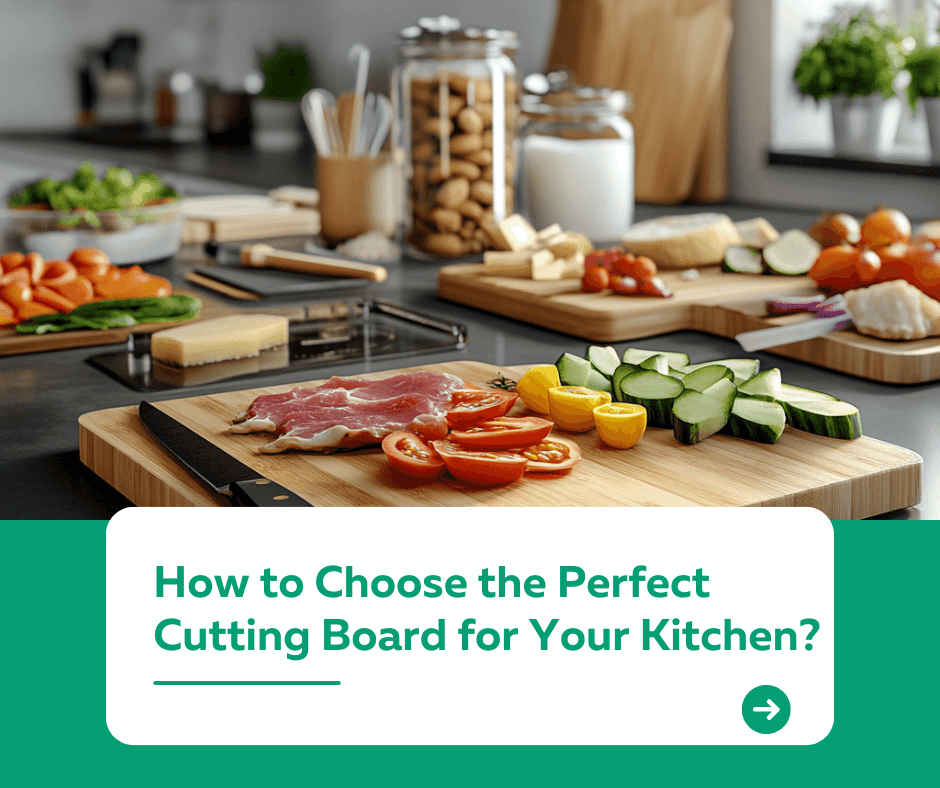
Introduction
A cutting board is an essential kitchen tool, but choosing the right one can be tricky. How do you choose the perfect cutting board for your kitchen? From material to size, the options are vast, and selecting the right one depends on your cooking habits and preferences. Here’s a guide to help you make the best choice.
1. Types of Cutting Board Materials
1.1 Wooden Cutting Boards
Wooden boards, especially those made from hardwood like maple or walnut, are a classic choice.
Pros:
✅ Durable and gentle on knives.
✅ Naturally resistant to bacteria.
✅ Aesthetic appeal for serving.
Cons:
- Requires regular maintenance like oiling.
- Can warp if not properly cared for.
Best For: Vegetables, fruits, and bread.
1.2 Plastic Cutting Boards
Plastic boards are lightweight and come in various colors and sizes.
Pros:
✅ Easy to clean and dishwasher-safe.
✅ Affordable and widely available.
✅ Ideal for handling raw meat.
Cons:
- Prone to knife marks, which can harbor bacteria.
- Less durable than wood.
Best For: Raw meat, poultry, and fish.
1.3 Bamboo Cutting Boards
Bamboo boards are an eco-friendly option gaining popularity.
Pros:
✅ Hard and durable surface.
✅ Environmentally sustainable.
✅ Resistant to water absorption.
Cons:
- Can dull knives over time.
- Requires occasional oiling.
Best For: General use and eco-conscious kitchens.
1.4 Glass Cutting Boards
Glass boards are sleek and modern but come with limitations.
Pros:
✅ Easy to clean and non-porous.
✅ Resistant to stains and odors.
✅ Stylish appearance.
Cons:
- Harsh on knives, dulling them quickly.
- Slippery surface can be unsafe.
Best For: Serving or presentation.
2. Factors to Consider When Choosing a Cutting Board
2.1 Size and Thickness
- Choose a size that fits your countertop and meets your cooking needs.
- Opt for thicker boards for heavy-duty chopping and thinner ones for portability.
2.2 Maintenance Requirements
- Wooden boards require regular oiling to prevent cracking.
- Plastic boards are easier to clean but may need replacement when deeply scratched.
2.3 Hygiene
- Use separate boards for raw meat and other foods to avoid cross-contamination.
- Choose materials that are easy to sanitize, like plastic or bamboo.
3. Additional Tips for Cutting Board Care
✅ Clean Immediately: Wash cutting boards with hot, soapy water after use.
✅ Sanitize Regularly: Use a vinegar or bleach solution for thorough cleaning.
✅ Avoid Excessive Water: Never soak wooden boards to prevent warping.
✅ Replace When Necessary: Discard boards with deep cuts or cracks that harbor bacteria.
Conclusion
Choosing the perfect cutting board depends on your cooking needs, kitchen style, and maintenance preferences. Wooden boards are great for durability and aesthetics, while plastic boards are ideal for raw meat. For more kitchen tips and product recommendations, visit our Kuestion.com.